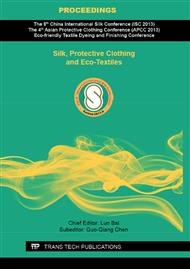[1]
S. H. Tan, R. Inai, M. Kotaki, S. Ramakrishna: Polymer. 46 (2005) 6128.
Google Scholar
[2]
K. H. Lee, O. Ohsawa, and S. Lee, et al: Sen'i Gakkaishi. 64 (2008) 306.
Google Scholar
[3]
J. H. Park, B. S. Kim, and Y. C. Yoo, et al: J. Appl. Polym. Sci. 107 (2007) 2211.
Google Scholar
[4]
J. Doshi, D. H. Reneker: J. Electrostat. 35 (1995) 151.
Google Scholar
[5]
K. Wei, T. Ohta, B. S. Kim and K. H. Lee, et al: Polym. Adv. Technol. 21 (2010) 746.
Google Scholar
[6]
J. M. Deitzel, J. Kleinmeyer and D. Harris, et al: Polymer. 42 (2001) 261.
Google Scholar
[7]
C. Chen, Y. H. Zhu and H. Bao, et al: Appl Mater Interfaces. 2 (2010) 1499.
Google Scholar
[8]
B. E. B. Jensen, A. A. A. Smith and B. Fejerskov, et al: Langmuir. 27 (2011) 10216.
Google Scholar
[9]
A. D. Ossipov, J. Hilborn: Macromolecules. 39 (2006) 1709.
Google Scholar
[10]
A. D. Ossipov, S. Piskounova and J. Hilborn: Macromolecules. 41 (2008) 3971.
Google Scholar
[11]
F. Cavalieri, E. Chiessi and R. Villa, et al: Biomacromolecules. 9 (2008) (1967).
Google Scholar
[12]
A. Bornat, US Patent 4689186. (1987).
Google Scholar
[13]
J. P . Berry , US Patent 4965110. (1990).
Google Scholar
[14]
A. Theron, E. Zussman, and A. L. Y arin: Nanotechnology. 12 (2001) 384.
Google Scholar
[15]
R. Dersch, T. Liu and A. K. Schaper, et al: J. Polym. Sci. -A: Polym. Chem. 41(2003) 545.
Google Scholar
[16]
J. M. Deitzel, J. Kleinme yer and J. K. Hirv onen, et al: Polymer. 42 (2001). 8163.
Google Scholar
[17]
K. Nobusawa, A. Ikeda and J. Kikuchi, et al: Chem. Int. Ed. 47 (2008) 4577.
Google Scholar
[18]
C. Hu, Z. Chen and A. Shen, et al: Carbon. 44 (2006) 428.
Google Scholar
[19]
F. Liang, J. M. Beach and P. K. Rai, et al: Chem. Mater. 18 (2006) 1520.
Google Scholar
[20]
J. L. Hudson, H. Jian and A. D. Leonard, et al: Chem. Mater. 18 (2006) 2766.
Google Scholar
[21]
J. J. Stephenson, J. L. Hudson and S. Azad, et al: Chem. Mater. 18 (2006) 374.
Google Scholar
[22]
J. Chattopadhyay, F. J. Cortez and S. Chakraborty, et al: Chem. Mater. 18 (2006) 5864.
Google Scholar
[23]
B. Jia, L. Gao: J. Phys. Chem. B. 111 (2007) 5337.
Google Scholar
[24]
M. N. Tchoul, W. T. Ford and G. lolli, et al: Chem. Mater. 19 (2007) 5765.
Google Scholar
[25]
A. G. Osorio, I. C. L. Silveira and V. L. Bueno, et al: Appl. Surf. Sci. 255 (2008) 2485.
Google Scholar
[26]
L. Zhang, Q. Q. Ni and Y. Q. Fu, et al: App. Surf. Sci. 255 (2009) 7095.
Google Scholar
[27]
J. Zou, L. Liu and H. Chen, et al: Adv. Mater. 20 (2008) (2055).
Google Scholar


